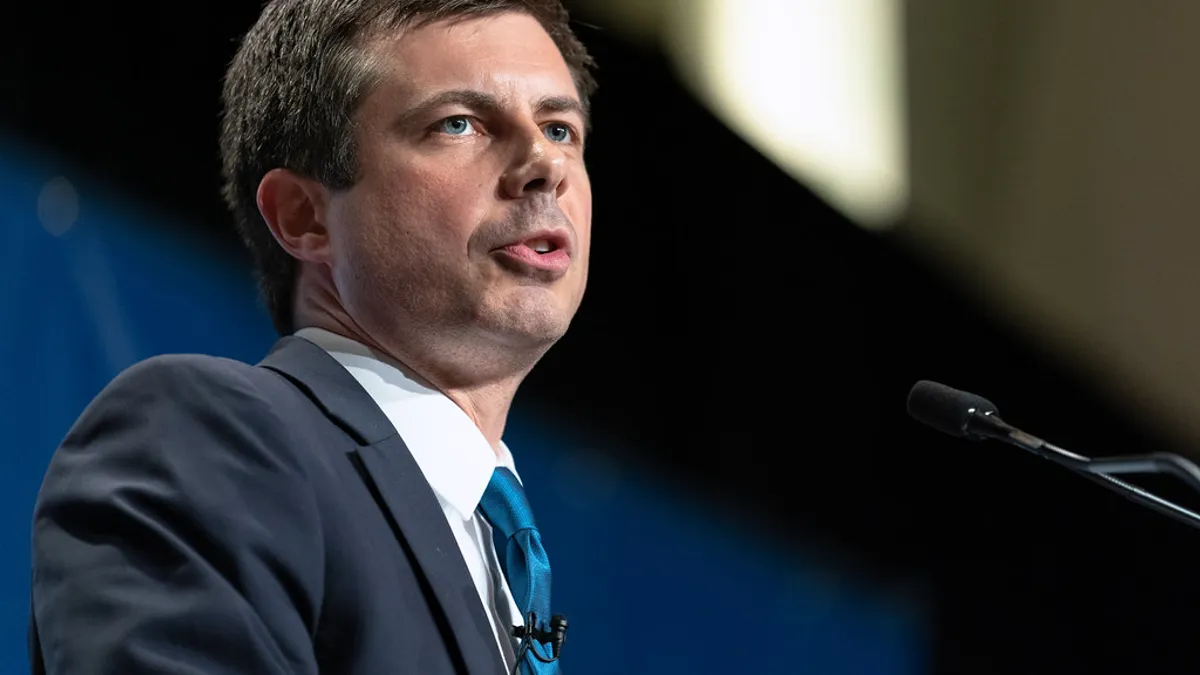President-elect Joe Biden has picked 2020 presidential candidate and former Mayor of South Bend, Indiana, Pete Buttigieg to be secretary of the Department of Transportation, Biden's transition team announced Tuesday.
While he has limited political experience, construction-related groups said they see promise in a Buttigieg-run DOT.
"It would certainly be good to have a former mayor from a city like South Bend in the post," said Brian Turmail, vice president of public affairs and strategic intiatives for the Associated General Contractors of America. "He is in a unique position to understand how vital good transportation connections are to the success of local manufacturers, educational institutions and main street businesses."
Buttigieg, who served as mayor for eight years, will also likely understand that "needless regulatory barriers will only delay vital infrastructure projects," Turmail added.
Another industry organization, the Amercian Society of Civil Engineers, was also upbeat in its assessment of the new secretary.
"As a mayor, he has seen firsthand how infrastructure policy and investment impact families, businesses, local economy and quality of life," executive director Tom Smith said in a statement, noting that Buttigieg was the first presidential candidate to respond to an ASCE-sponsored infrastructure forum in February.
During that event, Buttigieg "offered detailed, tangible plans for modernizing our nation’s roads, bridges, and water systems," Smith said.
Job creation, labor protection
The $1 trillion infrastructure plan Buttigieg unveiled in January as part of his presidential campaign also sheds light on how he will lead the DOT.
It included $165 billion for the Highway Trust Fund to make it solvent through 2029. This would be funded through a user-fee system — perhaps a vehicle-miles traveled fee, the plan suggested — to replace the gas tax.
Creating jobs was also a cornerstone of the infrastructure plan he released in January, as he looked to create 6 million "well-paying jobs with strong labor protections."
His plan called for updating and fixing at least half of all roads and bridges in poor conditions by 2030, with $50 billion in state grants to repair bridges.
The infrastructure document laid out the restoration of the Advisory Committee on Automation in Transportation, which the Trump administration dismantled, according to Buttigieg's plan. He proposed tasking the National Highway Traffic Safety Administration "with a strong federal role for regulation and oversight" to safely advance autonomous technology.
Buttigieg included electric vehicles in his infrastructure plan, to go hand-in-hand with his climate plan. The latter aimed to encourage the deployment of millions of EVs, and the infrastructure plan would fund the charging mechanism. Buttigieg proposed offering $6 billion in grants and loans for states and cities to partner with private companies and unions to do so.
That is in line with the Biden administration's goals. Biden aims to "put the United States on an irreversible path to achieve net-zero emissions, economy-wide, by no later than 2050," according to his campaign website. He has also hinted at modernizing highways and roads.
Taking the reins from Chao
The new DOT chief will pick up where an administration that worked on deregulation and collaborating with private companies left off. With Secretary Elaine Chao at the helm, these intents were evident in the agency's National Freight Strategic Plan, released in September. And President Donald Trump's executive order waiving environmental regulations accelerated infrastructure projects, though Congress has not passed an infrastructure bill.
The DOT boss will also inherit long-standing issues and have to reckon with the effects of a divided Congress in getting infrastructure initiatives off the ground. Nevertheless, construction industry leaders are hopeful about the opportunities that 38-year-old Buttigieg — Biden's youngest Cabinet nominee so far — could bring to the sector.
"We think his role as a former mayor will help him appreciate the value of investing in workforce development to help create more economic opportunities, especially in underserved communities that don’t have an established tradition of working in construction careers," Turmail added.














